List of World Heritage Sites in Italy

The United Nations Educational, Scientific and Cultural Organization (UNESCO) World Heritage Sites are places of importance to cultural or natural heritage as described in the UNESCO World Heritage Convention, established in 1972.[1] Cultural heritage consists of monuments (such as architectural works, monumental sculptures, or inscriptions), groups of buildings, and sites (including archaeological sites). Natural features (consisting of physical and biological formations), geological and physiographical formations (including habitats of threatened species of animals and plants), and natural sites which are important from the point of view of science, conservation or natural beauty, are defined as natural heritage.[2] Italy ratified the convention on June 23, 1978.[3]
As of 2024[update], Italy has 60 listed sites, making it the state party with the most World Heritage Sites, just above China (59).[3][4] The first site in Italy, the Rock Drawings in Valcamonica, was listed at the 3rd Session of the World Heritage Committee, held in Cairo and Luxor, Egypt, in 1979.[5] Twenty-five Italian sites were added during the 1990s, including 10 sites added at the 21st session held in Naples in 1997. Italy has served as a member of the World Heritage Committee five times, 1978–1985, 1987–1993, 1993–1999, 1999–2001, and 2021–2025.[3]
Out of Italy's 60 heritage sites, 54 are cultural and 6 are natural.[3] Seven sites are transnational. The Historic Centre of Rome is shared with the Vatican; the Monte San Giorgio and Rhaetian Railway with Switzerland; the Venetian Works of Defence with Croatia and Montenegro; the Prehistoric pile dwellings around the Alps with 5 other countries; The Great Spa Towns of Europe with 6 other countries; and the Ancient and Primeval Beech Forests of the Carpathians and Other Regions of Europe are shared with 17 other countries. In addition, Italy has 32 sites on the tentative list.[3]
World Heritage Sites
[edit]UNESCO lists sites under ten criteria; each entry must meet at least one of the criteria. Criteria i through vi are cultural, and vii through x are natural.[6]
| Site | Image | Location (province) | Year listed | UNESCO data | Description |
|---|---|---|---|---|---|
| Rock Drawings in Valcamonica | 
|
Brescia | 1979 | 94; iii, vi (cultural) | Valcamonica is home to one of the largest collections of petroglyphs in the world. Over 140,000 carvings were created in the valley over a period of 8,000 years from the Epipalaeolithic to the Middle Ages. They depict scenes from agriculture, navigation, war, and magic.[7][8] |
| Historic Centre of Rome, the Properties of the Holy See in that City Enjoying Extraterritorial Rights and San Paolo Fuori le Mura* | 
|
Metropolitan City of Rome Capital | 1980 | 91ter; i, ii, iii, iv, vi (cultural) | The city of Rome was the centre of the Roman Empire, and later, of the Christian world. It is home to a large number of major monuments of antiquity, including the Colosseum (pictured), the Pantheon, and the Roman Forum, as well as buildings from the Renaissance and Baroque periods. Originally listed as the "Historic Centre of Rome", the site was expanded in 1990 and renamed to the current name. Another boundary modification took place in 2015. The site is shared with the Holy See.[9] |
| Church and Dominican Convent of Santa Maria delle Grazie with "The Last Supper" by Leonardo da Vinci | 
|
Metropolitan City of Milan | 1980 | 93; i, ii (cultural) | The complex of the Dominican Convent in Milan was constructed in the second half of the 15th century; it is partially attributed to Bramante. The northern wall of the reflectory of the convent features the mural of The Last Supper by Leonardo da Vinci, a masterpiece of High Renaissance art.[10] |
| Historic Centre of Florence | 
|
Metropolitan City of Florence | 1982 | 174ter; i, ii, iii, iv, vi (cultural) | The city of Florence is the symbol of the Renaissance and was an important centre of Renaissance humanism. It has had a profound influence on the architecture and arts of Italy and Europe, being associated with artists such as Giotto, Brunelleschi, Botticelli, and Michelangelo. Monuments in the city include the Florence Cathedral, Basilica of Santa Croce, the Uffizi, and the Palazzo Pitti. Minor boundary modifications of the site took place in 2015 and 2021. Piazza della Signoria is pictured.[11] |
| Venice and its Lagoon | 
|
Metropolitan City of Venice | 1987 | 394; i, ii, iii, iv, v, vi (cultural) | The city of Venice was founded in the 5th century and developed into a major maritime power, the Republic of Venice, in the 10th century. It is built on over 100 islands in the lagoon and contains monuments such as the St Mark's Basilica, the Doge's Palace, and numerous churches and bridges. Even after its decline in political power, Venice remained influential in the field of arts, with the innovations by painters Bellini, Giorgione, Titian, Tintoretto, Veronese, and Tiepolo. Venice is also associated with the 13th-century explorer Marco Polo.[12] |
| Piazza del Duomo, Pisa | 
|
Pisa | 1987 | 395bis; i, ii, iv, vi (cultural) | Piazza dei Miracoli is one of the finest medieval architectural complexes in the world and comprises four masterpieces from the 11th to 14th century: the cathedral, the baptistry, the cemetery, and the leaning tower. The Pisan Romanesque style developed here was influential in other Tuscan cities. The complex is also associated with Galileo Galilei, who conducted his experiments there. A minor boundary modification took place in 2007.[13][14] |
| Historic Centre of San Gimignano | 
|
Siena | 1990 | 550; i, iii, iv (cultural) | The town of San Gimignano was an important stop for pilgrims on the Via Francigena in the Middle Ages. The city preserves its medieval character, with its most prominent feature being the high towers, built between the 11th and the 13th century by noble families and upper middle-class merchants. Fourteen of these towers have survived to the present day. Churches and palaces of the town are home to several masterpieces of artists from the 14th and 15th centuries.[15] |
| The Sassi and the Park of the Rupestrian Churches of Matera | 
|
Matera | 1993 | 670; iii, iv, v (cultural) | This site comprises two districts of Matera, with cave dwellings first occupied in the Paleolithic. People inhabited the natural caves in the karst plateau of Murge and later started carving and building more elaborate structures, including churches, monasteries, and hermitages. The Romanesque Matera Cathedral dates to the 13th century.[16] |
| City of Vicenza and the Palladian Villas of the Veneto | 
|
Padua, Rovigo, Treviso, Metropolitan City of Venice, Verona, Vicenza | 1994 | 712; i, ii (cultural) | In the 16th century, while under the Republic of Venice, several villas were built in the city of Vicenza and the surrounding Veneto region by the architect Andrea Palladio (1508–80). His designs had a profound influence on the architecture and inspired the Palladian style. Originally listed in 1994 as "Vicenza, City of Palladio", the site was expanded in 1996 to include several villas in the region. Villa Chiericati is pictured.[17][18] |
| Historic Centre of Siena | 
|
Siena | 1995 | 717; i, ii, iv (cultural) | The city of Siena has preserved its medieval Gothic character from the 12th to 15th century. The city is built around the Piazza del Campo. Several important Renaissance painters worked and were born in Siena, including Duccio, Ambrogio Lorenzetti, and Simone Martini. The Siena Cathedral is pictured.[19] |
| Historic Centre of Naples | 
|
Metropolitan City of Naples | 1995 | 726bis; ii, iv (cultural) | Naples, founded in 470 BCE by Greek colonists, was one of the most important cities of Magna Grecia, of the Roman Republic, and the capital of the Kingdom of Naples under several royal houses. It was highly influential on European arts and architecture. Some of the important monuments include the Church of Santa Chiara from the 14th century, the Castel Nuovo from the 13th century (pictured), and the Royal Palace from the 17th century. A minor boundary modification took place in 2011.[20] |
| Crespi d'Adda | 
|
Bergamo | 1995 | 730; iv, v (cultural) | Crespi d'Adda is a well preserved company town built in the 19th and 20th centuries for the workforce of a textile manufacturer Cristoforo Crespi. The town includes both residential buildings and common public services such as a clinic, a school, theatre, and sports centre. Some of the buildings are still in use.[21] |
| Ferrara, City of the Renaissance, and its Po Delta | 
|
Ferrara | 1995 | 733bis; ii, iii, iv, v, vi (cultural) | Ferrara, the seat of the House of Este, was an intellectual and artistic centre during the Italian Renaissance of the 15th and 16th centuries. It attracted artists to decorate several mansions and palaces (Este Castle pictured), while the architectural school influenced the styles in Italy and Europe. Originally listed as "Ferrara, city of the Renaissance", the site was expanded in 1999 to include the cultural landscape of the Po Delta.[22][23] |
| Castel del Monte | 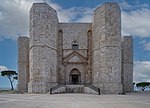
|
Barletta-Andria-Trani | 1996 | 398rev; i, ii, iii (cultural) | The octagonal castle was built by Emperor Frederick II in the 13th century. It blends northern European Cistercian Gothic, Muslim architecture, and elements from Classical antiquity in a perfectly symmetrical design.[24] |
| The Trulli of Alberobello | 
|
Bari | 1996 | 787; iii, iv, v (cultural) | The trulli are traditional limestone huts, typical of the Apulia region. They were constructed from at least the mid-14th century in a prehistoric drywall technique, usually featuring conical, domed or pyramidal roofs of corbelled stone slabs. The World Heritage Site lists the trulli in the town of Alberobello, with over 1500 preserved structures.[25] |
| Early Christian Monuments of Ravenna | 
|
Ravenna | 1996 | 788; i, ii, iii, iv (cultural) | This site comprises eight monuments in the city of Ravenna, which was the seat of the Roman Empire in the 5th century. The churches and mausolea are decorated with mosaics of outstanding artistic quality that mix motifs from Western and Byzantine arts. The Basilica of San Vitale is pictured.[26] |
| Historic Centre of the City of Pienza | 
|
Siena | 1996 | 789; i, ii, iv (cultural) | In 1459, Pope Pius II decided to transform his hometown of Pienza according to Renaissance Humanist ideas of urban design. The project was supervised by the architect Bernardo Rossellino who built new squares, churches, and palaces. Pienza was later a model for urban development in other Italian and European cities.[27] |
| 18th-Century Royal Palace at Caserta with the Park, the Aqueduct of Vanvitelli, and the San Leucio Complex | 
|
Caserta and Benevento | 1997 | 549rev; i, ii, iii, iv (cultural) | This large scale palace complex was commissioned by the Bourbon King of Naples Charles III in the mid-18th century. It was designed by the architect Luigi Vanvitelli and inspired by palaces in Versailles and Madrid. Following the ideas of the Enlightenment, the complex is well integrated into the landscape. The site includes an aqueduct and the industrial complex of San Leucio where silk was produced.[28] |
| Residences of the Royal House of Savoy | 
|
Metropolitan City of Turin, Cuneo | 1997 | 823bis; i, ii, iv, v (cultural) | This site comprises 22 palaces and villas constructed to demonstrate the power of the ruling monarchy following the move of the capital of the House of Savoy to Turin by Emmanuel Philibert in 1562. The buildings, mostly in Baroque style, are representative of 17th and 18th century European monumental architecture. A minor boundary modification took place in 2010. The Palazzina di caccia of Stupinigi is pictured.[29][30] |
| Botanical Garden (Orto Botanico), Padua | 
|
Padua | 1997 | 824; ii, iii (cultural) | Padua's botanical garden was founded in 1545 as the world's first university botanical garden. It has been a centre of scientific research for centuries, as well as a template for other gardens. It was renovated in the 18th century but still retains its original layout.[31] |
| Portovenere, Cinque Terre, and the Islands (Palmaria, Tino and Tinetto) | 
|
La Spezia | 1997 | 826bis; ii, iv, v (cultural) | The cultural landscape along the Ligurian coast has been shaped by humans over the past millennium. There are several scenic small towns built among the steep rugged terrain, and the land has been converted to terraces. There are also three islands off the coast with remains of early monastic buildings. A minor boundary modification took place in 2021. A church in Porto Venere is pictured.[32] |
| Cathedral, Torre Civica and Piazza Grande, Modena | 
|
Modena | 1997 | 827; i, ii, iii, iv (cultural) | The 12th-century complex, comprising the cathedral, the tower, and the square, is an excellent example of early Romanesque art, with strong influence on the development of the style. The cathedral was designed by the architect Lanfranco and decorated by the sculptor Wiligelmo.[33] |
| Archaeological Areas of Pompei, Herculaneum and Torre Annunziata | 
|
Metropolitan City of Naples | 1997 | 829; iii, iv, v (cultural) | This site comprises three sites that were buried under volcanic ash during the eruption of Mount Vesuvius in 79 CE. The towns of Pompeii and Herculaneum are two Roman towns that have been preserved completely and provide insight into the life in the 1st century CE while the two villas at Torre Annunziata have well preserved wall paintings. The sites have been progressively excavated since the mid-18th century.[34] |
| Amalfi Coast (Costiera Amalfitana) | 
|
Salerno | 1997 | 830; ii, iv, v (cultural) | The Mediterranean cultural landscape of the Amalfi Coast was shaped prominently during the time of the medieval Duchy of Amalfi (from the 9th to 11th century) in a mixture of Western and Byzantine influences. The coast includes towns, such as Amalfi and Ravello, as well as vineyards, orchards, and pastures, at the point where the mountains are touching the sea.[35] |
| Archaeological Area of Agrigento | 
|
Agrigento | 1997 | 831; i, ii, iii, iv (cultural) | Agrigento, a Greek colony founded in the 6th century BCE, developed into one of the major cities of Magna Graecia and of the Mediterranean. Several Doric temples have been preserved, and they represent one of the most notable sites of Greek art and culture.[36] |
| Villa Romana del Casale | 
|
Enna | 1997 | 832; i, ii, iii (cultural) | The villa in Piazza Armerina is one of the most luxurious Roman villas built in the early 4th century, and is a representative example of the economy and social structure of its period. It is richly decorated with mosaics of exceptional quality, it represents the finest in situ collection of Roman mosaics in the world.[37] |
| Su Nuraxi di Barumini | 
|
South Sardinia | 1997 | 833; i, iii, iv (cultural) | Su Nuraxi is the finest and the most complete example of nuraghe, a defensive megalithic structure of the Bronze Age Nuragic civilization of the 2nd millennium BCE. Unique to Sardinia, nuraghi are circular defensive towers in the form of truncated cones with internal chambers. The one at Su Nuraxi was originally over 18.5 m (61 ft) high. The site was abandoned in the 6th century BCE and most nuraghi went out of use after Roman colonization in the 2nd century BCE.[38] |
| Archaeological Area and the Patriarchal Basilica of Aquileia | 
|
Udine | 1998 | 825ter; iii, iv, vi (cultural) | Aquileia was one of the wealthiest cities of the early Roman Empire. In 452, it was sacked by the Huns under Attila; most of the ancient city now remains preserved and unexcavated. The Patriarchal Basilica, with its mosaic floors, dates to the 4th century. It was rebuilt between the 11th and 14th centuries. It played a major role in the spreading of Christianity to a large part of Central Europe in the early Middle Ages. Minor boundary modifications took place in 2017 and 2018.[39] |
| Historic Centre of Urbino | 
|
Pesaro and Urbino | 1998 | 828; ii, iv (cultural) | In the 15th century, Urbino flourished under the leadership of Federico da Montefeltro, a humanist who attracted some of the most prominent scientists and artists to the city. The city's Renaissance architecture has been largely preserved as Urbino entered cultural and economic stagnation from the 16th century onward.[40] |
| Cilento and Vallo di Diano National Park with the Archeological sites of Paestum and Velia, and the Certosa di Padula | 
|
Salerno | 1998 | 842; iii, iv (cultural) | The cultural landscape was shaped by different societies through centuries, including Etruscans, Lucanians, Greek colonists, and later Romans. The site includes the remains of Paestum and Velia, two major towns from classical times. The Carthusian monastery Certosa di Padula dates to 1306, although most of the present buildings are from the 17th and 18th centuries in the Baroque style.[41] |
| Villa Adriana, Tivoli | 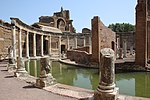
|
Metropolitan City of Rome Capital | 1999 | 907; i, ii, iii (cultural) | Villa Adriana or "Hadrian's Villa" in Tivoli, outside Rome, was built in the 2nd century CE as a retreat for the Emperor Hadrian. It combines architectural elements from Greece, Egypt, and Rome. The complex includes residential and recreational buildings, gardens, and pools. Its rediscovery in the mid-15th century influenced the architects of the Renaissance and Baroque periods.[42] |
| City of Verona | 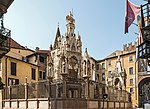
|
Verona | 2000 | 797rev; ii, iv (cultural) | Verona, founded as a Roman town in the 1st century BCE, has developed uninterruptedly for over 2,000 years and preserves urban structures and monuments from different periods. They include the Roman amphiteatre and Roman gate, the Gothic Scaliger Tombs (pictured), as well as several historic squares and palaces.[43] |
| Isole Eolie (Aeolian Islands) | 
|
Messina | 2000 | 908; viii (natural) | This archipelago off the coast of Sicily has been extensively studied by geologists at least since the 18th century. The islands contain several classical features of volcanic landforms, which were important in the development of volcanology as a scientific discipline. Two types of volcanic eruptions bear names after the islands of the archipelago, Strombolian and Vulcanian.[44] |
| Assisi, the Basilica of San Francesco and Other Franciscan Sites | 
|
Perugia | 2000 | 990; i, ii, iii, iv, vi (cultural) | Assisi was the birthplace of Saint Francis, founder of the Franciscan order. The Basilica was built in the 13th century. It features paintings by Cimabue, Pietro Lorenzetti, Simone Martini, and Giotto, and has been a reference point for Italian and Western art.[45] |
| Villa d'Este, Tivoli | 
|
Metropolitan City of Rome Capital | 2001 | 1025; i, ii, iii, iv, vi (cultural) | The 16th century-gardens of Vila d'Este are one of the first and best examples of Italian Renaissance gardens. The gardens have a geometric layout in line with Renaissance aesthetics and are decorated with pools and fountains, designed by Pirro Ligorio. They had a large influence on European garden design.[46] |
| Late Baroque Towns of the Val di Noto (South-Eastern Sicily) | 
|
Catania, Ragusa, Syracuse | 2002 | 1024; i, ii, iv, v (cultural) | In 1693, a powerful earthquake hit Sicily, destroying several towns and cities. In the aftermath, the towns of Caltagirone, Militello Val di Catania, Catania, Modica, Noto, Palazzolo, Ragusa, and Scicli were rebuilt in line with the Baroque urban planning trends. They represent the pinnacle of late Baroque art in Europe.[47] |
| Sacri Monti of Piedmont and Lombardy | 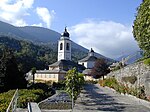
|
several sites | 2003 | 1068rev; ii, iv (cultural) | The phenomena of Sacri Monti (Sacred Mountains) began at the end of the 15th century with an aim of creating alternative pilgrimage and prayer sites due to inaccessibility of the Holy Land. The site comprises nine such complexes in Piedmont and Lombardy built in the late 16th and 17th centuries. They are rich in arts and are well integrated into the landscape. The Sacred Mount Calvary of Domodossola is pictured.[48] |
| Val d'Orcia | 
|
Siena | 2004 | 1026rev; iv, vi (cultural) | The cultural landscape of Val d'Orcia in the hinterland of Siena was carefully redesigned during the 14th and 15th century in line with the Renaissance aesthetical ideals. The landscape consists of small villages, towns, fields, pastures, meadows, and small farms. It has featured prominently on the paintings of the Sienese School.[49] |
| Etruscan Necropolises of Cerveteri and Tarquinia | 
|
Viterbo, Metropolitan City of Rome Capital | 2004 | 1158; i, iii, iv (cultural) | Cerveteri and Tarquinia are two Etruscan cemeteries from the 9th to the 1st century BCE. Several tombs that were designed as replicas of Etruscan houses are decorated with outstanding wall paintings depicting scenes of daily life (the Tomb of the Leopards pictured).[50] |
| Syracuse and the Rocky Necropolis of Pantalica | 
|
Syracuse | 2005 | 1200; ii, iii, iv, vi (cultural) | Syracuse was founded in the 8th century BCE by the Corinthians and became one of the most important cities of Magna Graecia. An important monument from this period is the Doric Temple of Apollo. The Necropolis of Pantalica (pictured) contains more than 5,000 tombs, most dating from the 13th to the 7th centuries BCE, and remains of Byzantine era structures.[51] |
| Genoa: Le Strade Nuove and the system of the Palazzi dei Rolli | 
|
Metropolitan City of Genoa | 2006 | 1211; ii, iv (cultural) | This site comprises two urban developments in Genoa from the 16th and 17th centuries, when the Republic of Genoa was at the peak of its power. Le Strade Nuove (New Streets) are a group of streets (including Via Giuseppe Garibaldi) built by the Genoese aristocracy. The Palazzi dei Rolli (Palaces of the Lists) are a group of Renaissance and Baroque palaces which were associated to a particular system of public lodging in private residences, whereby notable guests on State visit to the Republic were hosted in one of these palaces on behalf of the State. Palazzo Cattaneo Belimbau is pictured.[52] |
| Rhaetian Railway in the Albula / Bernina Landscapes* | 
|
Sondrio | 2008 | 1276; ii, iv (cultural) | The Albula and Bernina lines of the Rhaetian Railway are two historic railway lines that cross the Swiss Alps. They were built in the early 20th century, providing a rapid and easy route into many formerly isolated alpine settlements. Building the railroads required overcoming technical challenges with bridges, galleries, and tunnels. The site is shared with Switzerland. The train station in Tirano is pictured.[53] |
| Mantua and Sabbioneta | 
|
Mantua | 2008 | 1287; ii, iii (cultural) | These two towns represent two approaches of Renaissance period town planning. Mantua (pictured), originating in Roman times and preserving structures from the 11th century, was renovated in the 15th and 16th centuries. On the other hand, Sabbioneta was founded in the second half of the 16th century by Vespasiano I Gonzaga and built with a grid plan, according to the period's vision of an ideal city.[54] |
| The Dolomites | 
|
several sites | 2009 | 1237rev; vii, viii (natural) | This site comprises nine areas of the Dolomites, a mountain range in the northern Italian Alps. There are 18 peaks above 3,000 m (9,800 ft), with mountain scenery including sheer rocky cliffs, vertical walls, long and narrow valleys. From the geological perspective, the rocks contain fossils record of marine life in the Triassic period. Marmolada is pictured.[55] |
| Monte San Giorgio* | 
|
Varese | 2010 | 1090; viii (natural) | Monte San Giorgio, overlooking Lake Lugano, preserves the best fossil record of marine life from the Triassic Period (245–230 million years ago). In that period, the area was a tropical lagoon, flourishing with reptiles, fish, bivalves, ammonites, echinoderms, and crustaceans. Fossils of terrestrial animals are also preserved. The part of the property in Switzerland was listed in 2003 and expanded to include the Italian part in 2010.[56] |
| Longobards in Italy. Places of the power (568-774 A.D.) | 
|
several sites | 2011 | 1318; ii, iii, vi (cultural) | This site comprises seven groups of monasteries, churches, and fortresses associated with the Longobards who ruled in Italy from the 6th to the 8th century. The arts and architecture reflect the synthesis of Roman, Christian, and Germanic influences. The monuments listed are located in Brescia, Cividale del Friuli (artwork in the Oratorio di Santa Maria in Valle pictured), Castelseprio, Spoleto, Campello sul Clitunno, Benevento, and Monte Sant'Angelo. Its architecture marks a synthesis of various styles and the transition to the Middle Ages.[57] |
| Prehistoric Pile dwellings around the Alps* | 
|
several sites | 2011 | 1363; iv, v (cultural) | This transnational site (shared with Austria, France, Germany, Slovenia, and Switzerland) contains 111 small individual sites with the remains of prehistoric pile-dwelling (or stilt house) settlements in and around the Alps built from around 5000 to 500 BCE on the edges of lakes, rivers, or wetlands. They contain a wealth of information on life and trade in agrarian Neolithic and Bronze Age cultures in Alpine Europe. Nineteen sites are located in Italy, the reconstruction of a house at Ledro is pictured.[58] |
| Medici Villas and Gardens in Tuscany | 
|
several sites | 2013 | 175; ii, iv, vi (cultural) | This site comprises twelve villas and two gardens built under the patronage of the Medici family from the 15th to 17th centuries in Tuscany. They represent a new type of aristocratic residences, in departure from military castles or rich farms. The villas and gardens were places of leisure, arts, and knowledge, and they were designed in line with the principles of Renaissance humanism. The Villa Medici in Fiesole is pictured.[59] |
| Mount Etna | 
|
Catania | 2013 | 1427; viii (natural) | Mount Etna is the most active stratovolcano in the world, as well as one of the most studied volcanoes, with at least 2,700 years of documented history. It features several typical volcanic phenomena, such as cinder cones, lava flows, and lava caves. The mountain is home to several endemic animal and plant species.[60] |
| Vineyard Landscape of Piedmont: Langhe-Roero and Monferrato | 
|
Alessandria, Asti, Cuneo | 2014 | 1390rev; iii, v (cultural) | Winegrowing and processing for Piemonte wine has taken place in this area since at least the 5th century BCE. The cultural landscape contains vineyards, villages, cellars, farms, and Romanesque churches. The site comprises five wine-producing areas and the Castle of Grinzane Cavour.[61] |
| Arab-Norman Palermo and the Cathedral Churches of Cefalù and Monreale | 
|
Metropolitan City of Palermo | 2015 | 1487; ii, iv (cultural) | This site comprises nine buildings, constructed during the time of the Norman Kingdom of Sicily (1130–1194) in a style that incorporates features of Arab, Byzantine, and Western art. Two palaces, three churches, three cathedrals (Palermo Cathedral pictured), and the Admiral's Bridge are listed.[62] |
| Ancient and Primeval Beech Forests of the Carpathians and Other Regions of Europe* | 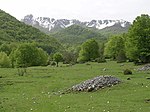
|
several sites | 2017 | 1133ter; ix (natural) | The primeval beech forests provide an essential resource for understanding the history and evolution of the beech tree (Fagus sylvatica) over the last million years. The site was first listed in 2007 in Slovakia and Ukraine. It was extended in 2011, 2017, and 2021 to include forests in a total of 18 countries. The 13 forests listed in Italy were inscribed in 2017 and 2021. Val Fondillo is pictured.[63] |
| Venetian Works of Defence between the 16th and 17th centuries: Stato da Terra – Western Stato da Mar* | 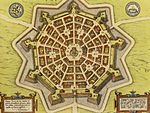
|
Bergamo, Udine, Verona | 2017 | 1533; iii, iv (cultural) | This property consists of six components of defence works in Italy, Croatia, and Montenegro, spanning more than 1,000 km (620 mi) between the Lombard region of Italy and the eastern Adriatic Coast. The design of the fortifications (termed alla moderna) was marked by the introduction of gunpowder to warfare, which led to significant shifts in military techniques and architecture. Three sites are listed in Italy: the star fort of Palmanova (map pictured) and the fortifications of Bergamo and Peschiera del Garda.[64] |
| Ivrea, Industrial City of the 20th Century | 
|
Metropolitan City of Turin | 2018 | 1538bis; iv (cultural) | The Industrial City of Ivrea was founded in 1908 by Camillo Olivetti, head of the company Olivetti S.p.A. that produced typewriters, mechanical calculators, and office computers. The city was, mostly between 1930 and the 1960s, designed in line with the ideas of the political Community Movement. The complex includes industrial, residential, and public buildings, and expresses a modern vision of the relationship between industrial production and architecture. A minor boundary modification took place in 2021.[65] |
| The Prosecco Hills of Conegliano and Valdobbiadene. ("Le Colline del Prosecco di Conegliano e Valdobbiadene") | 
|
Treviso | 2019 | 1571rev; v (cultural) | The cultural landscape of Conegliano and Valdobbiadene is characterized by hogback hills (ciglioni) that have been terraced and converted to vineyards since the 17th century. The region produces the Prosecco wine. The landscape also includes forests, hedges, farms, and villages.[66] |
| The Great Spa Towns of Europe* | 
|
Pistoia | 2021 | 1613; ii, iii, iv, vi (cultural) | The Great Spa Towns of Europe comprises 11 spa towns in seven European countries where mineral waters were used for healing and therapeutic purposes before the development of industrial medication in the 19th century. The town of Montecatini Terme is listed in Italy.[67] |
| Padua's fourteenth-century fresco cycles | 
|
Padua | 2021 | 1623; ii (cultural) | The site comprises eight buildings, both religious and secular, in four clusters. They house fresco cycles that were painted between 1302 and 1397 by several prominent painters: Giotto, Guariento di Arpo, Giusto de' Menabuoi, Altichiero da Zevio, Jacopo d'Avanzi, and Jacopo da Verona. The frescos are innovative in their way of depicting allegorical narrative and use new techniques of perspective. The Scrovegni Chapel is pictured.[68] |
| The Porticoes of Bologna | 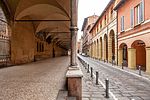
|
Metropolitan City of Bologna | 2021 | 1650; iv (cultural) | Porticoes represent an important cultural and architectural heritage of the city of Bologna. For centuries, they have been used as sheltered walkways and as prime locations for merchant activities. They were constructed in wood, brick, stone, and in the 20th century also in reinforced concrete. Sometimes they cover both sides of the street. Twelve portico complexes are listed.[69] |
| Evaporitic Karst and Caves of Northern Apennines | 
|
several sites | 2023 | 1692; viii (natural) | This site comprises four areas with evaporite karst, two with Triassic anhydrites, and two with Messinian gypsum (example from the Gessi Bolognesi Park pictured). There are over 700 caves that exhibit a wide variety of karst features and contain rare minerals. They are also inhabited by several plant species, many of which are endangered.[70][71] |
| Via Appia. Regina Viarum | 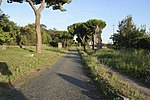
|
several sites | 2024 | 1708; iii, iv, vi (cultural) | Via Appia was one of the earliest and strategically most important Roman roads. Built in 312 BCE, it connected Rome and Brindisi. Revolutionary in road design, it bypassed towns along the way, featured several bridges and viaducts, it was paved with close-fitting slabs of dressed basalt, and it was toll-free and public. It was in use until the Middle Ages and, following renovations, even in later periods. The section at Casal Rotondo is pictured.[72] |
Tentative list
[edit]In addition to the sites inscribed on the World Heritage List, member states can maintain a list of tentative sites that they may consider for nomination. Nominations for the World Heritage List are only accepted if the site has previously been listed on the tentative list.[73] As of 2024[update], Italy recorded 32 tentative sites.[3]
| Site | Image | Location (province) | Year listed | UNESCO criteria | Description |
|---|---|---|---|---|---|
| Lake Maggiore and Lake D'Orta lakelands | 
|
Novara, Verbano-Cusio-Ossola | 2006 | ii, vi (cultural) | The cultural landscape of the lakelands has been shaped since the 16th century, with villas and gardens constructed on the coasts of lakes and on the islands for wealthy owners. Since the 19th century, the area has become a popular holiday destination. The buildings are from the Renaissance, Baroque, and Neoclassical periods. San Giulio Island in Lake D'Orta is pictured.[74] |
| Hanbury botanical gardens | 
|
Imperia | 2006 | ii, iv (cultural) | The botanical gardens were set up by Sir Thomas Hanbury in the second half of the 19th century. The aims of the garden were to grow non-European exotic plants and botanical experimentations. The gardens became a prototype for the similar gardens in Liguria and beyond.[75] |
| Orvieto | 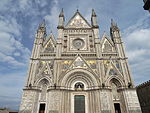
|
Terni | 2006 | i, iv, v (cultural) | Orvieto was an Etruscan town which reached its peak between the 6th and 4th centuries BCE and then declined in the Roman times. In the Middle Ages, it rose to prominence in the 13th and 14th centuries, when the cathedral (pictured) was built. The highly decorated facade is a masterpiece of Italian Gothic architecture.[76] |
| Villas of the Papal Nobility | 
|
Viterbo, Metropolitan City of Rome Capital | 2006 | i, ii, iii, iv (cultural) | This site comprises 15 suburban villas built from the second half of the 16th century onwards for higher clergymen and nobles related to the papal court. They were designed by some of the most prominent architects of the period, including Gian Lorenzo Bernini and Francesco Borromini, and they were decorated by leading artists. Villas are typically surrounded by parks and gardens. Villa Farnese is pictured.[77] |
| Salento and the "Barocco Leccese" | 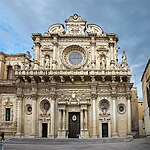
|
Lecce | 2006 | i, iii, iv (cultural) | The Salento peninsula has been shaped by numerous civilizations over centuries, with prehistoric remains from the Messapians. A defining feature of the area is the so-called "Barocco Leccese", a form of Baroque that developed in Lecce during the Counter-Reformation. The style is highly decorative and aims to display the power of the Catholic Church. The Basilica of Santa Croce is pictured.[78] |
| Cattolica Monastery in Stilo and Basilian-Byzantine complexes | 
|
Reggio Calabria | 2006 | ii, iii, iv (cultural) | Between the 6th and 11th centuries, Calabria was under the influence of the Byzantine Empire. This is reflected in the church architecture and the monasteries, often situated in caves. The monasteries attracted hermits fleeing from Syria and Egypt, bringing their traditions with them. The nomination comprises several churches and related buildings.[79] |
| Archipelago of La Maddalena and Islands of Bocche di Bonifacio* | 
|
Sassari | 2006 | vii, ix, x (natural) | The archipelago is located in the Strait of Bonifacio between the islands of Sardinia and Corsica and is shared between Italy and France. The area is an important habitat for different cetacean species. The sea floor is covered by meadows of Posidonia oceanica.[80] |
| Mothia Island and Lilibeo: The Phoenician-Punic Civilization in Italy | 
|
Trapani | 2006 | iii, iv, vi (cultural) | Mothia was a Punic settlement on an island off the coast of Sicily, founded in the 7th century BCE. Many carved stele have been preserved from the period. The town was sacked by the Syracusans in 398 BCE. The survivors settled in Lilibelo which developed into a military stronghold until it was taken over by the Romans during the Punic Wars. It prospered under the Romans as well.[81] |
| Bradyseism in the Flegrea Area | 
|
Metropolitan City of Naples | 2006 | vii, viii, x (natural) | Bradyseism is the gradual uplift or descent of land caused by the filling or emptying of underground magma chambers. This effect is well demonstrated in the Macellum of Pozzuoli (formerly known as Serapeum, pictured), a Roman monument where marine molluscs bore holes in the columns that are now up to 7 m (23 ft) above the floor of the monument, indicating that the area was at some point submerged under the sea.[82] |
| Cascata delle Marmore and Valnerina: Monastic sites and ancient hydrogeological reclamation works | 
|
Perugia, Terni | 2006 | i, iv, v, vi (cultural) | Valnerina, the valley of the Nera river, attracted Syriac monks who settled there in the 4th century. In the following centuries, the hermitages developed into monasteries. The monks modified the terrain by draining the marshes and redirecting the rivers to create farming land. The Cascata delle Marmore (pictured) is an artificial waterfall, created by Consul Manius Curius Dentatus in 271 BCE to prevent flooding in the Rieti Valley. In modern times, hydroelectric power plants have been installed on the rivers.[83] |
| Pelagos: The Cetacean Sanctuary* | 
|
several sites | 2006 | vii, ix, x (natural) | The protected area off the coast of Liguria, Sardinia, and Tuscany, as well as in the territorial waters of Monaco and France, covers about 100,000 km2 (39,000 sq mi). It is home for many species of whales and other marine fauna. A striped dolphin is pictured.[84] |
| Island of Asinara | 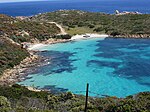
|
Sassari | 2006 | vii, ix, x (natural) | The island off the coast of Sardinia is interesting from the geological perspective, with rare black amphibolite, metamorphic rocks that are 950 million years old. The island has been inhabited since prehistory, used as pastures, and since the late 19th century as a prison, penal colony, concentration camp for soldiers, and a quarantine station.[85] |
| Sulcis Iglesiente | 
|
Oristano, Cagliari | 2006 | ix, x (natural) | Iglesiente, on the island of Sardinia, is the most important mining area in Italy. The deposits of lead, zinc, and silver were exploited by the Nuragic civilization, Punic people, and the Romans. In Sulcis, coal mines (infrastructure pictured) were set up in the 19th century. Mining ended in the late 20th century.[86] |
| The Marble Basin of Carrara | 
|
Massa-Carrara | 2006 | ii, vi, vii, viii, ix, x (mixed) | High-quality marble was extracted from the Apuan Alps around Carrara already in the Roman times and there are several quarry sites from the Renaissance period. Technical heritage from different periods related to marble has been preserved as well.[87] |
| The Transhumance: The Royal Shepherd's Track | 
|
several sites | 2006 | ii, iii, x (mixed) | Transhumance is a type of pastoralism or nomadism, a seasonal movement of livestock between fixed summer and winter pastures. In Italy, this practice has origins in pre-Roman times and continues to the present day. Shepherd's tracks are connected into a network of roads with the supporting infrastructure such as taverns, sanctuaries, and weaving mills. Transhumance is practiced in Abruzzo (landscape pictured), Molise, Campania, and Apulia. The archaeological site of Saepinum is located at one of the tracks.[88] |
| Volterra: Historical City and Cultural Landscape | 
|
Pisa | 2006 | iv, v (cultural) | Volterra is a hilltop town that was settled by the Etruscans and later by the Romans. A Roman theatre has been preserved on the hill slope. In the 15th century, a Renaissance fortress was built under Lorenzo de' Medici. Today, the town mostly preserves its medieval character.[89] |
| The Aniene valley and Villa Gregoriana in Tivoli | 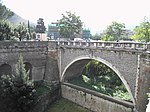
|
Metropolitan City of Rome Capital | 2006 | i, ii, iii, iv (cultural) | The Aniene valley was an important source of water for the city of Rome. The first aqueduct was built in the 2nd century BCE by praetor Quintus Marcius Rex and two more in the times of the Roman Empire. There are Roman temples in the valley as well. Villa Gregoriana (bridge pictured) is a park that was commissioned in 1835 by Pope Gregory XVI to rebuild and regulate the bed of the Aniene river which was damaged in the 1826 flood.[90] |
| The Murge of Altamura | 
|
Metropolitan City of Bari | 2006 | iii, vii, viii (mixed) | Murge is a karst plateau composed mostly of Mesozoic limestone. There are several karst phenomena present, including caves and sinkholes. Thousands of dinosaur footprints, dating to 70 million years ago, have been found in De Lucia quarry. The Altamura Man, a complete skeleton of a Neanderthal man who got trapped in the Lamalunga cave about 130,000 years ago, was discovered in 1993.[91] |
| Karstic caves in prehistoric Apulia | 
|
Lecce | 2006 | i, ii, iii (cultural) | The Salento peninsula is composed of limestone and shows karst phenomena, including several caves. Grotta Romanelli in Castro and Grotta delle Veneri in Parabita were periodically inhabited in the Middle and Upper Paleolithic periods. Flake tools, bones, stone engravings and figurines have been found in the caves. Grotta dei Cervi near Otranto was occupied in the Neolithic. A reproduction of a petroglyph from the cave is pictured.[92] |
| Citadel of Alessandria | 
|
Alessandria | 2006 | ii, iii, iv (cultural) | The bastion fort near the city of Alessandria was built in 1713 upon an older fortification, by the House of Savoy who came into possession of the area. It was further expanded and fortified by the French under Napoleon. The fort also played a role in 1859 during the Second Italian War of Independence. The armory building is pictured.[93] |
| Mont Blanc massif* | 
|
Aosta Valley | 2008 | vii, viii, ix, x (natural) | Mont Blanc, with the height of 4,810 m (15,780 ft), is the highest peak of the Alps. The massif has several glaciers and is an important habitat for mountain flora and fauna. The nomination is shared with France and Switzerland.[94] |
| The cultural landscape of the Benedictine settlements in medieval Italy | 
|
several sites | 2016 | ii, v, vi (cultural) | This nomination comprises eight monasteries of Benedictines, a religious monastic order founded by Saint Benedict of Nursia in the 6th century. The monasteries were centres of culture and learning and were influential across Europe. They were located outside urban centres. The work of the monks has resulted in creation of a cultural landscape that focuses on coexistence with nature and preservation of the environment. Monte Cassino is pictured.[95] |
| Mediterranean Alps* | 
|
Cuneo, Imperia | 2017 | viii (natural) | This transnational nomination, shared with France and Monaco, covers parts of the Maritime Alps and the Ligurian Alps. This section of the Alps is interesting from a geological perspective as it provides an example of an uneroded range which formed 30 million years ago during the Alpine orogeny upon rocks dating to the Variscan orogeny 400 million years ago. In less than 70 km (43 mi), the mountains drop from 3,297 m (10,817 ft) (Monte Argentera) to the depth of 2,500 m (8,200 ft) in the Mediterranean basin.[96] |
| The Cultural Landscape of Civita di Bagnoregio | 
|
Viterbo | 2017 | iii, v (cultural) | Civita di Bagnoregio is a town on the top of a hill that has been settled at least since the Etruscan times. The terrain is made of tuff and fragile clay and is prone to landslides and erosion. The town demonstrates the struggle of people against a changing environment and was important in the development of studies of landslide management.[97] |
| Via Francigena in Italy | 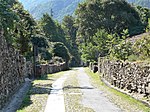
|
several sites | 2019 | ii, iv, vi (cultural) | Via Francigena is a medieval network of roads that were used by the pilgrims from the lands of Franks on their way to Rome. Pilgrimages were an important feature of cultural exchange between Italy and Northern Europe. Supporting infrastructure for the travelers included sanctuaries, hospices, monasteries, churches, post stations, and civil buildings. A section of the road in Aosta Valley is pictured.[98] |
| Art and Architecture in the Prehistory of Sardinia. The domus de janas. | 
|
several sites | 2021 | ii, iii, vi (cultural) | This nomination comprises sites of Pre-Nuragic cultures of Sardinia. They date from the Neolithic to Bronze Age, from the 5th to the 3rd millennium BCE. Sites include megalithic sites and hypogea, more specifically menhirs, dolmens, stone circles, and chamber tombs. The latter are called Domus de Janas, "The house of the fairies", and some have walls decorated with paintings. The tomb at Lotzorai is pictured.[99] |
| Eocene Marine Biodiversity of the Alpone Valley | 
|
Verona, Vicenza | 2021 | viii (natural) | The Lagerstätte around Verona is exceptionally rich with fossils from the Tethys Ocean during the Eocene epoch (between 56 and 34 million years ago). Fossils from this tropical ecosystem include fish and marine mammals, marine invertebrates such as bivalves, gastropods, and crustaceans, as well as crocodiles, turtles, and birds. Studies of fossils have been taking place since at least the 16th century. A fish from the Monte Bolca site is pictured.[100] |
| Historical theatres of the Marche Region | 
|
several sites | 2021 | ii, iv, vi (cultural) | This nomination comprises 61 theatres in the Marche region. They date from the 16th to the 19th century and are often located in smaller towns, sometimes in municipal buildings or manor houses. The design of the theatres changed through centuries. They were visited by all social classes. They preserve rich libraries of text and musical sheets. The Teatro dell'Aquila in Fermo is pictured.[101] |
| Nuragic monuments of Sardinia | 
|
several sites | 2021 | ii, iv, v (cultural) | This nomination comprises 31 sites of the Nuragic civilization of Sardinia from the 2nd millennium BCE. The characteristic feature of this civilization are nuraghe, defensive megalithic structures. Apart from nuraghe, nominated sites also include the remains of temples, sanctuaries, and settlements. Su Nuraxi is already listed as a World Heritage Site. Nuraghe Majori is pictured.[102] |
| The system of the Ville-fattoria in Chianti Classico | 
|
Florence, Siena | 2023 | ii, iv, v (cultural) | The cultural landscape between the provinces of Florence and Siena was developed in the 16th century, after Siena came under the influence of the House of Medici. The land organization was based on the Villa-fattoria system, which saw the centralization of the administration and modernization of agricultural production. The hilly terrain is especially appropriate for Chianti wine production (vinyards in Gaiole in Chianti pictured).[103] |
| Evidence of Italo-Greek Culture between the Early and Late Middle Ages | 
|
Calabria | 2023 | ii, iii, vi (cultural) | The nomination includes sites that bear testimony to Greek-Byzantine culture in southern Italy: the city of Gerace, Baptistery of Santa Severina, Oratorium of San Marco a Rossano, Catholic of Stilo, and Orthodox Monastery of Saint Giovanni Theristìs in Bivongi (pictured).[104] |
| European Paper Mills (from the era of hand-made paper)* | 
|
Tuscany | 2024 | ii, iii, iv (cultural) | This transnational nomination comprises six 16th–18th century paper mills that show the importance of Europe in paper production. The Pescia Paper Mill is nominated in Italy.[105] |
See also
[edit]References
[edit]- ^ "The World Heritage Convention". UNESCO World Heritage Centre. Archived from the original on 27 August 2016. Retrieved 7 July 2019.
- ^ "Convention Concerning the Protection of the World Cultural and Natural Heritage". UNESCO World Heritage Centre. Archived from the original on 1 February 2021. Retrieved 3 February 2021.
- ^ a b c d e f "Italy". UNESCO World Heritage Centre. Archived from the original on December 1, 2021. Retrieved June 5, 2024.
- ^ "World Heritage List". UNESCO World Heritage Centre. Archived from the original on 2020-11-02. Retrieved 2021-12-20.
- ^ "Report of the Rapporteur". UNESCO World Heritage Centre. November 30, 1979. Archived from the original on July 5, 2020. Retrieved July 12, 2014.
- ^ "UNESCO World Heritage Centre – The Criteria for Selection". UNESCO World Heritage Centre. Archived from the original on 12 June 2016. Retrieved 17 August 2018.
- ^ "Rock Drawings in Valcamonica". UNESCO World Heritage Centre. Archived from the original on 3 July 2010. Retrieved 26 June 2010.
- ^ Emmanuel Anati. "The Way of Life Recorded in the Rock Art of Valcamonica" (PDF). Tanum Museum of Rock Carvings. Archived (PDF) from the original on 28 November 2021. Retrieved 24 December 2021.
- ^ "Historic Centre of Rome, the Properties of the Holy See in that City Enjoying Extraterritorial Rights and San Paolo Fuori le Mura". UNESCO World Heritage Centre. Archived from the original on 24 February 2011. Retrieved 26 June 2010.
- ^ "Church and Dominican Convent of Santa Maria delle Grazie with "The Last Supper" by Leonardo da Vinci". UNESCO World Heritage Centre. Archived from the original on 4 July 2010. Retrieved 26 June 2010.
- ^ "Historic Centre of Florence". UNESCO World Heritage Centre. Archived from the original on 3 July 2010. Retrieved 26 June 2010.
- ^ "Venice and its Lagoon". UNESCO World Heritage Centre. Archived from the original on 3 July 2010. Retrieved 26 June 2010.
- ^ "Piazza del Duomo, Pisa". UNESCO World Heritage Centre. Archived from the original on 2 September 2016. Retrieved 26 June 2010.
- ^ "Decision – 31COM 8B.61 – Nomination of natural, mixed and cultural properties to the world heritage list – Piazza del Duomo, Pisa". UNESCO World Heritage Centre. Archived from the original on 8 November 2011. Retrieved 26 June 2010.
- ^ "Historic Centre of San Gimignano". UNESCO World Heritage Centre. Archived from the original on 4 July 2010. Retrieved 26 June 2010.
- ^ "The Sassi and the Park of the Rupestrian Churches of Matera". UNESCO World Heritage Centre. Archived from the original on 4 July 2010. Retrieved 26 June 2010.
- ^ "City of Vicenza and the Palladian Villas of the Veneto". UNESCO World Heritage Centre. Archived from the original on 3 July 2010. Retrieved 26 June 2010.
- ^ "Decision – 20COM VIII.C – Extension and Change of Name: The City of Vicenza and the Palladian Villas of the Veneto (Italy)". UNESCO World Heritage Centre. Archived from the original on 27 February 2013. Retrieved 26 June 2010.
- ^ "Historic Centre of Siena". UNESCO World Heritage Centre. Archived from the original on 3 July 2010. Retrieved 26 June 2010.
- ^ "Historic Centre of Naples". UNESCO World Heritage Centre. Archived from the original on 19 May 2021. Retrieved 26 June 2010.
- ^ "Crespi d'Adda". UNESCO World Heritage Centre. Archived from the original on 4 July 2010. Retrieved 26 June 2010.
- ^ "Ferrara, City of the Renaissance, and its Po Delta". UNESCO World Heritage Centre. Archived from the original on 4 July 2010. Retrieved 26 June 2010.
- ^ "Decision – 23COM VIII.C.2 – Extension: Ferrara, City of the Renaissance and its Po Delta (extension of Ferrara, city of the Renaissance) (Italy)". UNESCO World Heritage Centre. Archived from the original on 2 March 2013. Retrieved 26 June 2010.
- ^ "Castel del Monte". UNESCO World Heritage Centre. Archived from the original on 3 July 2010. Retrieved 26 June 2010.
- ^ "The Trulli of Alberobello". UNESCO World Heritage Centre. Archived from the original on 3 July 2010. Retrieved 26 June 2010.
- ^ "Early Christian Monuments of Ravenna". UNESCO World Heritage Centre. Archived from the original on 3 July 2010. Retrieved 26 June 2010.
- ^ "Historic Centre of the City of Pienza". UNESCO World Heritage Centre. Archived from the original on 4 July 2010. Retrieved 26 June 2010.
- ^ "18th-Century Royal Palace at Caserta with the Park, the Aqueduct of Vanvitelli, and the San Leucio Complex". UNESCO World Heritage Centre. Archived from the original on 4 July 2010. Retrieved 26 June 2010.
- ^ "Residences of the Royal House of Savoy". UNESCO World Heritage Centre. Archived from the original on 4 July 2010. Retrieved 26 June 2010.
- ^ "Decision – 34COM 8B.58 – Cultural Properties – Examination of minor boundary modifications – Residences of the Royal House of Savoy (Italy)". UNESCO World Heritage Centre. Archived from the original on 8 November 2011. Retrieved 26 June 2010.
- ^ "Botanical Garden (Orto Botanico), Padua". UNESCO World Heritage Centre. Archived from the original on 4 July 2010. Retrieved 26 June 2010.
- ^ "Portovenere, Cinque Terre, and the Islands (Palmaria, Tino and Tinetto)". UNESCO World Heritage Centre. Archived from the original on 4 July 2010. Retrieved 26 June 2010.
- ^ "Cathedral, Torre Civica and Piazza Grande, Modena". UNESCO World Heritage Centre. Archived from the original on 27 December 2009. Retrieved 26 June 2010.
- ^ "Archaeological Areas of Pompei, Herculaneum and Torre Annunziata". UNESCO World Heritage Centre. Archived from the original on 4 July 2010. Retrieved 26 June 2010.
- ^ "Costiera Amalfitana". UNESCO World Heritage Centre. Archived from the original on 4 July 2010. Retrieved 26 June 2010.
- ^ "Archaeological Area of Agrigento". UNESCO World Heritage Centre. Archived from the original on 7 August 2010. Retrieved 26 June 2010.
- ^ "Villa Romana del Casale". UNESCO World Heritage Centre. Archived from the original on 26 August 2010. Retrieved 26 June 2010.
- ^ "Su Nuraxi di Barumini". UNESCO World Heritage Centre. Archived from the original on 3 July 2010. Retrieved 26 June 2010.
- ^ "Archaeological Area and the Patriarchal Basilica of Aquileia". UNESCO World Heritage Centre. Archived from the original on 16 December 2005. Retrieved 26 June 2010.
- ^ "Historic Centre of Urbino". UNESCO World Heritage Centre. Archived from the original on 19 January 2013. Retrieved 26 June 2010.
- ^ "Cilento and Vallo di Diano National Park with the Archeological sites of Paestum and Velia, and the Certosa di Padula". UNESCO World Heritage Centre. Archived from the original on 3 July 2010. Retrieved 26 June 2010.
- ^ "Villa Adriana (Tivoli)". UNESCO World Heritage Centre. Archived from the original on 20 December 2021. Retrieved 26 June 2010.
- ^ "City of Verona". UNESCO World Heritage Centre. Archived from the original on 3 July 2010. Retrieved 26 June 2010.
- ^ "Isole Eolie (Aeolian Islands)". UNESCO World Heritage Centre. Archived from the original on 3 July 2010. Retrieved 26 June 2010.
- ^ "Assisi, the Basilica of San Francesco and Other Franciscan Sites". UNESCO World Heritage Centre. Archived from the original on 3 July 2010. Retrieved 26 June 2010.
- ^ "Villa d'Este, Tivoli". UNESCO World Heritage Centre. Archived from the original on 20 December 2021. Retrieved 26 June 2010.
- ^ "Late Baroque Towns of the Val di Noto (South-Eastern Sicily)". UNESCO World Heritage Centre. Archived from the original on 3 July 2010. Retrieved 26 June 2010.
- ^ "Sacri Monti of Piedmont and Lombardy". UNESCO World Heritage Centre. Archived from the original on 2 April 2011. Retrieved 26 June 2010.
- ^ "Val d'Orcia". UNESCO World Heritage Centre. Archived from the original on 4 July 2010. Retrieved 26 June 2010.
- ^ "Etruscan Necropolises of Cerveteri and Tarquinia". UNESCO World Heritage Centre. Archived from the original on 3 July 2010. Retrieved 26 June 2010.
- ^ "Syracuse and the Rocky Necropolis of Pantalica". UNESCO World Heritage Centre. Archived from the original on 4 July 2010. Retrieved 26 June 2010.
- ^ "Genoa: Le Strade Nuove and the system of the Palazzi dei Rolli". UNESCO World Heritage Centre. Archived from the original on 21 June 2010. Retrieved 26 June 2010.
- ^ "Rhaetian Railway in the Albula / Bernina Landscapes". UNESCO World Heritage Centre. Archived from the original on 2 March 2012. Retrieved 10 December 2020.
- ^ "Mantua and Sabbioneta". UNESCO World Heritage Centre. Archived from the original on 28 October 2010. Retrieved 26 June 2010.
- ^ "The Dolomites". UNESCO World Heritage Centre. Archived from the original on 4 July 2010. Retrieved 26 June 2010.
- ^ "Monte San Giorgio". UNESCO World Heritage Centre. Archived from the original on 6 February 2012. Retrieved 10 December 2020.
- ^ "Longobards in Italy. Places of the power (568–774 A.D.)". UNESCO World Heritage Centre. Archived from the original on 30 June 2011. Retrieved 26 June 2010.
- ^ "Prehistoric Pile Dwellings Around the Alps". UNESCO World Heritage Centre. Archived from the original on 3 October 2020. Retrieved 10 December 2020.
- ^ "Medici Villas and Gardens in Tuscany". UNESCO World Heritage Centre. Archived from the original on 20 August 2013. Retrieved 4 August 2013.
- ^ "Mount Etna". UNESCO World Heritage Centre. Archived from the original on 6 August 2013. Retrieved 4 August 2013.
- ^ "Vineyard Landscape of Piedmont: Langhe-Roero and Monferrato". UNESCO World Heritage Centre. Archived from the original on 28 July 2014. Retrieved 29 July 2014.
- ^ "Arab-Norman Palermo and the Cathedral Churches of Cefalú and Monreale". UNESCO World Heritage Centre. Archived from the original on 17 December 2021. Retrieved 18 December 2021.
- ^ "Ancient and Primeval Beech Forests of the Carpathians and Other Regions of Europe". UNESCO World Heritage Centre. Archived from the original on 2 March 2012. Retrieved 7 September 2017.
- ^ "Venetian Works of Defence between the 16th and 17th Centuries: Stato da Terra – Western Stato da Mar". UNESCO World Heritage Centre. Archived from the original on 6 September 2017. Retrieved 30 August 2017.
- ^ "Ivrea, industrial city of the 20th century". UNESCO. Archived from the original on 2021-11-27. Retrieved 2019-12-26.
 This article incorporates text from this source, which is in the public domain.
This article incorporates text from this source, which is in the public domain.
- ^ "The Prosecco Hills of Conegliano and Valdobbiadene". UNESCO. Archived from the original on 2020-10-07. Retrieved 2019-09-23.
- ^ "The Great Spa Towns of Europe". UNESCO World Heritage Centre. Archived from the original on 28 July 2021. Retrieved 1 August 2021.
- ^ "Padua's fourteenth-century fresco cycles". UNESCO World Heritage Centre. Archived from the original on 24 July 2021. Retrieved 27 December 2021.
- ^ "The Porticoes of Bologna". UNESCO World Heritage Centre. Archived from the original on 18 December 2021. Retrieved 27 December 2021.
- ^ "Evaporite karst and caves of Emilia Romagna Region". UNESCO World Heritage Centre. Archived from the original on 3 December 2021. Retrieved 1 January 2022.
- ^ "Evaporitic Karst and Caves of Northern Apennines". UNESCO World Heritage Centre. Retrieved 20 September 2023.
- ^ "Via Appia. Regina Viarum". UNESCO World Heritage Centre. Retrieved 1 August 2024.
- ^ "Tentative Lists". UNESCO. Archived from the original on July 29, 2020. Retrieved July 12, 2014.
- ^ "Lake Maggiore and Lake D'Orta lakelands". UNESCO World Heritage Centre. Archived from the original on 1 January 2022. Retrieved 1 January 2022.
- ^ "Hanbury botanical gardens". UNESCO World Heritage Centre. Archived from the original on 1 January 2022. Retrieved 1 January 2022.
- ^ "Orvieto". UNESCO World Heritage Centre. Archived from the original on 3 December 2021. Retrieved 1 January 2022.
- ^ "Villas of the Papal Nobility". UNESCO World Heritage Centre. Archived from the original on 3 December 2021. Retrieved 1 January 2022.
- ^ "Salento and the "Barocco Leccese"". UNESCO World Heritage Centre. Archived from the original on 3 December 2021. Retrieved 1 January 2022.
- ^ "Cattolica Monastery in Stilo and Basilian-Byzantine complexes". UNESCO World Heritage Centre. Archived from the original on 3 December 2021. Retrieved 1 January 2022.
- ^ "Archipelago of La Maddalena and Islands of Bocche di Bonifacio". UNESCO World Heritage Centre. Archived from the original on 3 December 2021. Retrieved 1 January 2022.
- ^ "Mothia Island and Lilibeo: The Phoenician-Punic Civilization in Italy". UNESCO World Heritage Centre. Archived from the original on 3 December 2021. Retrieved 1 January 2022.
- ^ "Bradyseism in the Flegrea Area". UNESCO World Heritage Centre. Archived from the original on 28 December 2021. Retrieved 1 January 2022.
- ^ "Cascata delle Marmore and Valnerina: Monastic sites and ancient hydrogeological reclamation works". UNESCO World Heritage Centre. Archived from the original on 3 December 2021. Retrieved 1 January 2022.
- ^ "Pelagos: The Cetacean Sanctuary". UNESCO World Heritage Centre. Archived from the original on 3 December 2021. Retrieved 1 January 2022.
- ^ "Island of Asinara". UNESCO World Heritage Centre. Archived from the original on 3 December 2021. Retrieved 1 January 2022.
- ^ "Sulcis Iglesiente". UNESCO World Heritage Centre. Archived from the original on 3 December 2021. Retrieved 1 January 2022.
- ^ "The Marble Basin of Carrara". UNESCO World Heritage Centre. Archived from the original on 3 December 2021. Retrieved 1 January 2022.
- ^ "The Transhumance: The Royal Shepherd's Track". UNESCO World Heritage Centre. Archived from the original on 3 December 2021. Retrieved 1 January 2022.
- ^ "Volterra: Historical City and Cultural Landscape". UNESCO World Heritage Centre. Archived from the original on 23 September 2015. Retrieved 1 January 2022.
- ^ "The Aniene valley and Villa Gregoriana in Tivoli". UNESCO World Heritage Centre. Archived from the original on 19 December 2021. Retrieved 1 January 2022.
- ^ "The Murge of Altamura". UNESCO World Heritage Centre. Archived from the original on 3 December 2021. Retrieved 1 January 2022.
- ^ "Karstic caves in prehistoric Apulia". UNESCO World Heritage Centre. Archived from the original on 3 December 2021. Retrieved 1 January 2022.
- ^ "Citadel of Alessandria". UNESCO World Heritage Centre. Archived from the original on 3 December 2021. Retrieved 1 January 2022.
- ^ "Massif du Mont-Blanc (inscription comme patrimoine naturel transfrontalier, avec France et Suisse)" (in French). UNESCO World Heritage Centre. Archived from the original on 3 December 2021. Retrieved 1 January 2022.
- ^ "The cultural landscape of the Benedictine settlements in medieval Italy". UNESCO World Heritage Centre. Archived from the original on 3 December 2021. Retrieved 1 January 2022.
- ^ "Les Alpes de la Méditerranée (Italy)" (in French). UNESCO World Heritage Centre. Archived from the original on 3 December 2021. Retrieved 1 January 2022.
- ^ "The Cultural Landscape of Civita di Bagnoregio". UNESCO World Heritage Centre. Archived from the original on 3 December 2021. Retrieved 1 January 2022.
- ^ "Via Francigena in Italy". UNESCO World Heritage Centre. Archived from the original on 3 December 2021. Retrieved 1 January 2022.
- ^ "Art and Architecture in the Prehistory of Sardinia. The domus de janas". UNESCO World Heritage Centre. Archived from the original on 3 December 2021. Retrieved 1 January 2022.
- ^ "Eocene Marine Biodiversity of the Alpone Valley". UNESCO World Heritage Centre. Archived from the original on 3 December 2021. Retrieved 1 January 2022.
- ^ "Historical theatres of the Marche Region". UNESCO World Heritage Centre. Archived from the original on 5 December 2021. Retrieved 1 January 2022.
- ^ "Nuragic monuments of Sardinia". UNESCO World Heritage Centre. Archived from the original on 5 December 2021. Retrieved 1 January 2022.
- ^ "The system of the Ville-fattoria in Chianti Classico". UNESCO World Heritage Centre. Retrieved 1 January 2023.
- ^ "Evidence of Italo-Greek Culture between the Early and Late Middle Ages". UNESCO World Heritage Centre. 13 December 2023. Retrieved 5 June 2024.
- ^ "European Paper Mills (from the era of hand-made paper) (Italy)". UNESCO World Heritage Centre. 15 April 2024. Retrieved 5 June 2024.

